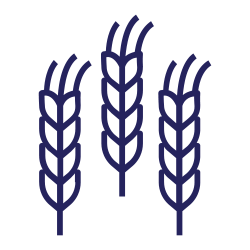Section Title
Selecting a New Cereal Variety
Crop Types
- Wheat
- Winter Wheat
There are many production resources available to farmers in Manitoba to assist in making decisions on their operations. Seed Manitoba may be one of the most valuable. When used in combination with information from seed growers, neighbours, agronomists and other experts, the seed guide can help farmers pick a variety that will perform under local growing conditions. Furthermore, Seed Manitoba provides information on variety performance under a wide range of growing conditions in location across Manitoba.
There are many considerations when selecting a new cereal variety. These include evaluating variety characteristics such as yield and protein content. But characteristics such as varietal disease packages and resistance ratings, days to maturity, standability and pre-harvest sprouting are all important considerations, as they can protect against yield and quality loss. In Western Canada, we have incredible genetics coming out of our breeding programs, both public and private. The cereal varieties bred at public institutions, such as Agriculture and Agri-Food Canada (AAFC) or the Crop Development Centre (CDC), are directly supported by farmer investment. Variety development would not be possible without the contributions from farmer members.
Disease and Insects
Seed Manitoba uses yield and protein data from the Manitoba Crop Variety Evaluation Trials (MCVET) to populate their tables. MCVET data is collected from small plot trial locations across Manitoba. At these trial locations, no fungicides are applied to the crops. The purpose of this is to get a true understanding of the genetic potential of each variety. However, the disease ratings provided in the seed guide are based on variety registration data, which is collected from inoculated disease nurseries across Western Canada. It’s important to note that the disease ratings provided in the seed guide are not set in stone, as ratings can change as pathogens adapt and genetic resistance breaks down over time. While foliar fungicide application is common, variety resistance is an important piece of a good overall integrated pest management plan, especially in environments with high disease risks. As well, if you find that your time is stretched thin during the fungicide spraying window, it’s recommended that you select a variety with a good disease package, as opposed to the top yielder.
Unfortunately, farmers in Manitoba must deal with managing Fusarium head blight (FHB) in their cereal crops. Something to keep in mind is that under severe disease pressure, all varieties will have some level of infection. A moderately resistant (MR) rating does not mean that variety is nearly immune. However, selecting a variety with a good FHB resistance rating will mitigate some risk. Seed should also be tested for presence of FHB and treated with a seed treatment if necessary.
Pressures from insects such as wheat midge and wheat stem sawfly can be partially mitigated by selecting a resistant variety. Seed Manitoba outlines the currently registered varieties that have partially solid stems which can provide some protection against wheat stem sawfly. Furthermore, the seed guide identifies varieties which are resistant to wheat midge and carry the Sm1 gene. The varieties are identified as a varietal blend (VB) in the Seed Guide and contain an interspersed refuge. Variety selection is an integral step in a good overarching integrated pest management plan.
Maturity
If it makes sense logistically on your farm, consider planting multiple varieties with varying maturities. This is a great way to spread out risk and it provide some flexibility when optimizing harvest timings. Depending on your growing region, an early maturing variety may be beneficial due to growing season length. As well, early maturing varieties can take advantage of improved harvest conditions in the fall, which may lead to improved grain quality. In Seed Manitoba, maturity ratings are reported as a value plus or minus 99 days for spring wheat and 88 days for barley.
Lodging and Sprouting
Both plant height and lodging resistance are key factors in keeping the crop standing in high-yielding environments, especially when applying high rates of nitrogen. If you find that a taller variety is most suited to your local environment, it may be worth it to consider a plant growth regulator (PGR), to aid in risk mitigation against lodging. The seed guide also outlines lodging resistance ratings for each variety. Plant heights values are reported plus or minus 81 cm for spring wheat, 89 cm for barley and 75 cm for winter wheat.
Pre-harvest sprouting (PHS) can be a large issue in Manitoba and be a challenge for farmer to manage. PHS is when the germination process begins when the seed is still on the plant, leading to reduced grain quality through the reduction of the falling number. Climate is a large factor which contribute to PHS, but another factor is variety genetics. As PHS can be detrimental to the grade of the grain, there has been efforts to breed resistance into varieties. Seed Manitoba provides relative resistance to sprouting ratings for spring wheat varieties. A variety with a poor (P) rating to pre-harvest sprouting is more likely to sprout under cool, wet growing conditions. While selection of a variety with either a good (G) or very good (VG) PHS rating is a way to spread out risk. All varieties will sustain sprouting damage if exposed to long periods of cool, wet weather.
End-Use Market
The end-use market for your grain is another aspect of variety selection that should be considered. Is your barley going to be used for malting or feed? Is your wheat destined for ethanol production, feed or human consumption? These questions can help guide variety selection as specific varieties are marketed to or desired by grain buyers and end-user because of their end-use characteristics.
Although many things need to be considered when planning for the upcoming growing season, variety selection is a simple and cost-effective way to maximize production profitability and is one of the few things that farmers can control.
Manitoba Crop Alliance (MCA) is proud to provide funding and data (for corn and sunflowers) to the MCVET trials.








